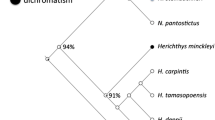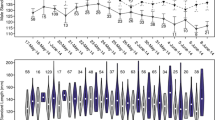Synopsis
The cichlid species flocks of the African Great Lakes represent the most extreme case of adaptive radiation among vertebrates. Recently, attention has focused on the potential for sexual selection to drive or accelerate speciation in these fishes. Cichlids as a whole are social in nature and display complex behavior, particularly during courtship and spawning; however, the extent to which changes in species recognition cues may account for species diversity among haplochromine lineages has remained speculative. Our investigations have indicated that oral incubating haplochromines show a reduction in diversity and extent of courtship relative to substrate brooding cichlids, and apparently retain aspects of a primitive specific mate recognition system. Laboratory observations of courtship in the Malawian endemicPseudotropheus zebra suggest that organization of the spawning bout is loose, and lacking in any well defined stimulus-response chain. Interspecific comparisons of in situ courtship behavior among male mbuna, lithophilous haplochromines of Lake Malawi, revealed only one potential example of species-specific behavior, and indicated that mate choice occurred prior to the onset of intense courtship. Courtship display by male mbuna does not appear critical to species recognition and may represent an evolutionary relict. Alternatively, male courtship display may have an indirect effect on successful reproduction or may be maintained through pleiotropic effects. The mbuna display no evidence of behavioral innovation and show limited interspecific differentiation in behavioral expression. More generally, there is no evidence at present to suggest that epigamic sexual selection, acting on courtship behavior, has been a major mechanism in the diversification of the haplochromine species flocks.
Similar content being viewed by others
References cited
Baerends, G.P. 1976. The significance of color patterns in fish for the study of some fundamental issues in behavior. Rev. Trav. Inst. Peches marit. 40: 413–423.
Baerends, G.P. & J.M. Baerends-van Roon. 1950. An introduction to the study of the ethology of cichlid fishes. Behaviour Suppl. 1: 1–242.
Bakeman, R. & J.M. Gottman. 1986. Observing interaction: an introduction to sequential analysis. Cambridge University Press, London. 221 pp.
Balon, E.K. 1977. Early ontogeny ofLabeotropheus Ahl, 1927 (Mbuna, Cichlidae, Lake Malawi), with a discussion on advanced protective styles in fish reproduction and development. Env. Biol. Fish. 2: 147–176.
Barlow, G.W. 1977. Modal action patterns. pp. 98–134.In: T.A. Seebok (ed.) How Animals Communicate, Indiana University Press, Bloomington.
Bartlett, M.S. 1951. The frequency goodness-of-fit test for probability chains. Proc. Cambridge Philos. Soc. 47: 89–95.
Baylis, J.R. 1976. A quantitative study of long-term courtship: II. A comparative study of the dynamics of courtship in two New World cichlid fishes. Behaviour 59: 117–161.
Carlstead, K. 1983. Influences of motivation on display divergences in three cichlid fish species (Haplochromis). Behaviour 83: 205–228.
Clarke, S.E., P.W. Colgan & N.P. Lester. 1984. Courtship sequences and ethological isolation in two species of sunfish (Lepomis spp.) and their hybrids. Behaviour 85: 93–114.
Crapon de Caprona, M.D. 1986. Are ‘preferences’ and ‘tolerances’ in cichlid mate choice important for speciation? J. Fish Biol. 29 (Suppl. A): 151–158.
Dominey, W.J. 1984. Effects of sexual selection and life history on speciation: Species flocks in African cichlids and HawaiianDrosophila. pp. 231–249.In: A.A. Echelle & I. Kornfield (ed.) Evolution of Fish Species Flocks, University of Maine Press, Orono.
Fagen, R.M. & N.J. Mankovich. 1980. Two-act transitions, partitioned contingency tables, and the ‘significant cells’ problem. Anim. Behav. 28: 1017–1023.
Fernald, R.D. 1975. Fast body turns in a cichlid fish. Nature 258: 228–229.
Fernald, R.D. & N.R. Hirata. 1977. Field study ofHaplochromis burtoni: quantitative behavioural observations. Anim. Behav. 25: 964–975.
Fryer, G. 1959. The trophic interrelationships and ecology of some littoral communities in Lake Nyasa with special reference to the fishes, and a discussion of the evolution of a group of rock-frequenting Cichlidae. Proc. zool. Soc. Lond. 132: 153–281.
Fryer, G. & T.D. Iles. 1972. The cichlid fishes of the Great Lakes of Africa. Their biology and evolution. Oliver & Boyd, Edinburgh. 641 pp.
Greenberg, B., J.J. Zijlstra & G.P. Baerends. 1965. A quantitative description of the behaviour changes during the reproductive cycle of the cichlid fishAequidens portalegrensis Hensel. Proc. Kon. Ned. Akad. Wet. Ser. C 68: 135–149.
Greenwood, P.H. 1981. The haplochromine fishes of the East African lakes. Cornell University Press, Ithaca. 839 pp.
Jandel Scientific, 1987. Sigma-Scan, Version 3.01. Jandel Scientific, Sausalito.
Kornfield, I. 1984. Descriptive genetics of cichlid fishes. pp. 591–616.In: B.J. Turner (ed.) Evolutionary Genetics of Fishes, Plenum Press, New York.
Kornfield, I. & J.N. Taylor. 1989. Is color sufficient? Female mate choice and specific status in an endemic cichlid fish from Lake Malawi. (in manuscript).
Kornfield, I., J.N. Taylor & J.A. Brown. 1989. Territoriality and behavior ofPseudotropheus zebra (Cichlidae) in Lake Malawi: potential for intermale sexual selection. Copeia (in press).
Lewis, D., P. Reinthal & J. Trendall. 1986. A guide to the fishes of Lake Malawi National Park. World Wildlife Fund Publications, Gland. 71 pp.
Liem, K.F. 1973. Evolutionary strategies and morphological innovations: cichlid pharyngeal jaws. Syst. Zool. 22: 425–441.
Liem, K.F. & J.W.M. Osse. 1975. Biological versatility, evolution, and food resource exploitation in African cichlid fishes. Amer. Zool. 15: 427–454.
Lowe-McConnell, R.H. 1956. The breeding behaviour ofTilapia species (Pisces: Cichlidae) in natural waters: observations onT. karomo Poll andT. variabilis Boulenger. Behaviour 9: 140–163.
Lowe-McConnell, R.H. 1957. Observations on the diagnosis and biology ofTilapia leucosticta Trewavas in East Africa. Rev. Zool. Bot. Afr. 55: 353–373.
Lowe-McConnell, R.H. 1959. Breeding behaviour patterns and ecological differences betweenTilapia species and their significance for evolution within the genusTilapia (Pisces: Cichlidae). J. Zool. 137: 1–31.
Martin, P. & P. Bateson. 1986. Measuring behavior. An introductory guide. Cambridge University Press, London. 200 pp.
Mayr, E. 1984. Evolution of fish species flocks; a commentary. pp. 3–11.In: A.A. Echelle & I. Kornfield (ed.) Evolution of Fish Species Flocks, University of Maine Press, Orono.
McKaye, K.R. 1983. Ecology and breeding behavior of a cichlid fish,Cyrtocara eucinostomus, on a large lek in Lake Malawi, Africa. Env. Biol. Fish. 8: 81–96.
McKaye, K.R. & W.N. Gray. 1984. Extrinsic barriers to gene flow in rock-dwelling cichlids of Lake Malawi: macrohabitat heterogeneity and reef colonization. pp. 169–184.In: A.A. Echelle & I. Kornfield (ed.) Evolution of Fish Species Flocks, University of Maine Press, Orono.
McKaye, K.R. & J.R. Stauffer, Jr. 1986. Description of a gold cichlid (Teleostei: Cichlidae) from Lake Malawi, Africa. Copeia 1986: 870–875.
Nelissen, M.H.J. 1976. Contribution to the ethology ofTropheus moorii Boulenger (Pisces, Cichlidae) and a discussion of the significance of its colour patterns. Rev. Zool. afr. 90: 17–29.
Nelissen, M.H.J. 1978. Contribution to the ethology ofTropheus brichardi Nelissen and Thys, 1975 (Pisces, Cichlidae). Acta Zool. et Path. Antiverpiensia 70: 141–147.
Noble, G.K. & B. Curtis. 1939. The social behaviour of the jewel fish,Hemichromis bimaculatus Gill. Bull. Am. Mus. nat. Hist. 76: 1–46.
Paterson, H.E.H. 1978. More evidence against speciation by reinforcement. S. Afr. J. Sci. 74: 369–371.
Paterson, H.E.H. 1980. A comment on ‘mate recognition systems’. Evolution 34: 330–331.
Paterson, H.E.H. 1985. The recognition concept of species. pp. 21–29.In: E.S. Vrba (ed.) Species and Speciation, Transvaal Mus. Monogr. 4, Transvaal Museum, Pretoria.
Polder, J.J.W. 1971.
Ribbink, A.J. 1986. The species concept, sibling species and speciation. Ann. Kon. Mus. Mid. Afr. Zool. Wetensch. 251: 109–116.
Ribbink, A.J., B.A. Marsh, A.C. Marsh, A.C. Ribbink & B.J. Sharp. 1983. A preliminary survey of the cichlid fishes of rocky habitats in Lake Malawi. S. Afr. J. Zool. 18: 149–310.
Satou, M., H. Takeuchi, K. Takei, T. Hasegawa, N. Okumoto & K. Ueda. 1987. Involvement of vibrational and visual cues in eliciting spawning behaviour in male Hime salmon (landlocked red salmon),Oncorhynchus nerka. Anim. Behav. 35: 1156–1558.
Sharp, B.J. 1981. An ecological study of territoriality in four cichlid species resident on rocky shores near Monkey Bay, Lake Malawi. M.S. Thesis, Rhodes University, Grahamstown. 187 pp.
Slater, P.J.B. 1973. Describing sequences of behavior. pp. 131–153.In: P.P.G. Bateson & P.H. Klopfer (ed.) Perspectives in Ethology, Plenum Press, New York.
Sokal, R.R. & F.J. Rohlf. 1981. Biometry. W.H. Freeman, San Francisco. 859 pp.
Thresher, R.E. 1984. Reproduction in reef fishes. T.F.H. Publications, Neptune City. 399 pp.
Trewavas, E. 1935. A synopsis of the cichlid fishes of Lake Nyasa. Ann. Mag. nat. Hist. (10) 16: 65–118.
Author information
Authors and Affiliations
Rights and permissions
About this article
Cite this article
McElroy, D.M., Kornfield, I. Sexual selection, reproductive behavior, and speciation in the mbuna species flock of Lake Malawi (Pisces: Cichlidae). Environ Biol Fish 28, 273–284 (1990). https://doi.org/10.1007/BF00751041
Received:
Accepted:
Issue Date:
DOI: https://doi.org/10.1007/BF00751041




